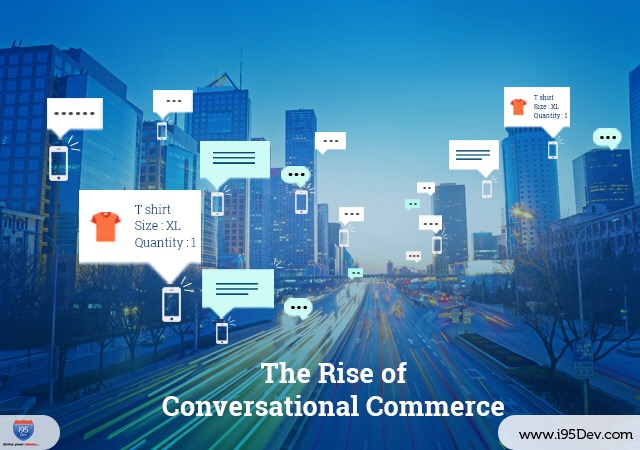As a result of which, we see changes in how consumers interact with brands to consume information, purchase products, share feedback, and more. We are seeing a shift from we publish you consume model to a conversational model. We are seeing Conversational Commerce soon becoming a trend.
Also Read: Top E-commerce Trends to Watch Out for in 2017
What is Conversational Commerce?
Conversational Commerce refers to the use of AI driven tools, like Chatbots and Virtual Assistants, by consumers to drive commerce. This includes the use of the tools to find answers, create shopping lists, seek recommendations, and placing orders.
The best thing about these tools, some of which allow two-way communication, is that they are effort less and already very widely used by consumers on a daily basis. Moreover, these tools are very likely to become the first touch point for consumers (who will appreciate the personalized human-like interaction that makes them feel special) to interact with brands (as they can very easily manage and drive simultaneous one-to-one conversations with multiple customers).
Chris Messina of Uber has noted that it might result in us talking to brands and companies over Facebook Messenger, WhatsApp, Telegram, Slack, and elsewhere, and finding it normal.
What is driving the growth of Conversational Commerce?
The two main factors trends driving the growth of Conversational commerce are:
Mobile messaging apps’ explosion: with a whole generation relying heavily on messaging as a means of communication, the messaging apps have gained a lot of popularity.
Consider this,
- The mobile (smartphone) penetration in the US is expected to reach 84.8% by 2018 (eMarketer).
- According to another research, smartphone users spend approximately 10% of their time on mobile social media (source).
Advances in Artificial Intelligence technology: it is now easier to process typed requests and categorize them to predict the expected answers. We even have companies that make it convenient for brands to design and deploy their own chat bots without any coding.
According to a survey conducted by US Consumer Survey in 2015, nearly 67% of respondents cited that they have a voice-controlled personal assistant on their device and nearly 75% of those have used it once or more than once (eMarketer).
Advances in payment technology: it was never this easy to accept and make payments online. The advances in payment technologies integration into devices and applications have a huge role to play in the increased adoption.
The tools enabling brands to communicate with customers?
The AI driven tools that are enabling conversational commerce are made available in mobile devices, messaging apps, website, and specific hardware devices like Google Home and Amazon Echo.
Here is a quick overview of the major initiatives shaping Conversational Commerce:
Facebook Messenger: Mark Zuckerberg at F8 in 2016 stated: “I don’t know anyone who likes calling a business. And no one wants to have to install a new app for every business or service that they interact with. We think you should be able to message a business, in the same way, you would message a friend.”
Facebook has made huge strides in the field of AI and has big plans to turn their messenger, their most popular app, into a business messaging powerhouse. Facebook even made peer-to-peer payments in app possible way back in 2015.
Today, you can book an Uber, purchase clothes, buy flowers, and more directly from the Facebook messenger.
WeChat: Tencent created WeChat three years ago. Three years later, WeChat, with 700 million monthly active users, has become the dominant mobile messaging platform in China.
Users use WeChat, not only as a means of communication but also to order food, buy concert and movie tickets, customize and purchase a pair of Nikes, and more. WeChat combines the chat interface with a variety of supplementary features such as a mobile wallet, interactive widgets and more, making it a complete package.
Amazon Echo: The device, powered by Alexa, was launched by Amazon as the perfect virtual assistant. Amazon Echo has gained a lot of popularity, with more than 3 million units sold in less than 18 months.
Alexa can play music, answer queries and control home devices. But, since it is an Amazon product, it can also tap into Amazon’s huge product catalog and place an order for you. Amazon Echo perfectly blends conversational commerce with Amazon’s digital commerce.
Google Allo: Taking a cue from Amazon’s Alexa, Google also launched its own AI voice assistant Allo. Given Google’s expertise in machine learning and its ecosystem, Allo holds a lot of promise for businesses. The time is not far when Allo will soon become the primary interface to interact with the family of Google Apps.
The brands that are setting the trend in Conversational Commerce?
- Sephora: Sephora launched its chatbot on Kik back in 2016. This chatbot asks users, who tried to contact Sephora, to provide some basic information through a quiz. It then uses that information to offer personalized beauty tips and product recommendations. The users can purchase the recommended products without leaving Kik app.
- Uber: As mentioned earlier, if you need a ride and if you happen to use Facebook Messenger, then you can book an Uber directly from your messaging app. The Uber chatbot accepts booking, provides status updates, and more.
- HealthTap: This digital health startup uses Facebook Messenger to connect users with more than 100,000 doctors. The company leverages chatbot, to understand and answer the frequently asked queries. For other queries, the user is automatically connected to the available doctor in the network.
- Bank of America: This banking behemoth is working on building a Facebook Messenger chatbot that will enable clients to stay updated about their finances whenever they want and wherever they want. The idea is to go beyond just alerts and enable users to access account data, transact, and more. MyKai, a banking chatbot, already offers similar services that through Facebook, Slack, Whatsapp, and SMS.
- Pizza Hut: This global restaurant chain now accepts orders through Facebook Messenger and Twitter chatbots. Customers can also connect their Facebook account to their Pizza Hut account and gain access to their order history. Pizza Hut further leverages this to personalize offers, accept reorders, etc. Dominos, their competitor, also has a similar system in place.


















